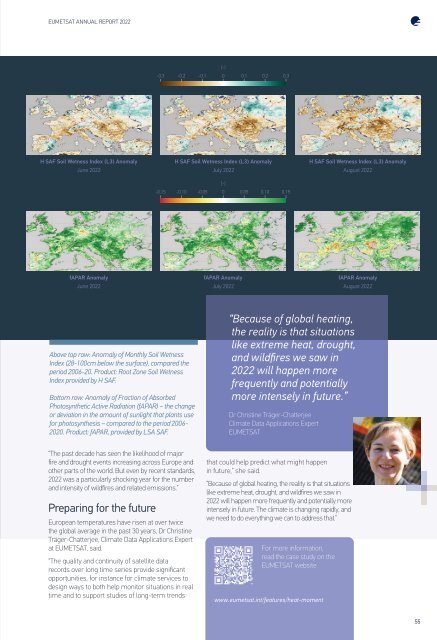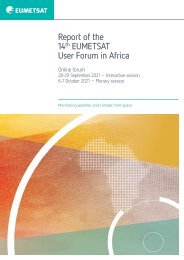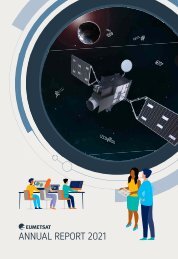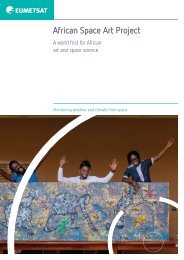EUMETSAT Annual Report 2022
Create successful ePaper yourself
Turn your PDF publications into a flip-book with our unique Google optimized e-Paper software.
<strong>EUMETSAT</strong> ANNUAL REPORT <strong>2022</strong><br />
[-]<br />
-0.3<br />
-0.2<br />
-0.1<br />
0<br />
0.1<br />
0.2<br />
0.3<br />
H SAF Soil Wetness Index (L3) Anomaly<br />
June <strong>2022</strong><br />
H SAF Soil Wetness Index (L3) Anomaly<br />
July <strong>2022</strong><br />
H SAF Soil Wetness Index (L3) Anomaly<br />
August <strong>2022</strong><br />
[-]<br />
-0.15<br />
-0.10<br />
-0.05<br />
0<br />
0.05<br />
0.10<br />
0.15<br />
fAPAR Anomaly<br />
June <strong>2022</strong><br />
fAPAR Anomaly<br />
July <strong>2022</strong><br />
fAPAR Anomaly<br />
August <strong>2022</strong><br />
Above top row: Anomaly of Monthly Soil Wetness<br />
Index (28-100cm below the surface), compared the<br />
period 2006-20. Product: Root Zone Soil Wetness<br />
Index provided by H SAF.<br />
Bottom row: Anomaly of Fraction of Absorbed<br />
Photosynthetic Active Radiation (fAPAR) – the change<br />
or deviation in the amount of sunlight that plants use<br />
for photosynthesis – compared to the period 2006-<br />
2020. Product: fAPAR, provided by LSA SAF.<br />
“Because of global heating,<br />
the reality is that situations<br />
like extreme heat, drought,<br />
and wildfires we saw in<br />
<strong>2022</strong> will happen more<br />
frequently and potentially<br />
more intensely in future.”<br />
Dr Christine Träger-Chatterjee<br />
Climate Data Applications Expert<br />
<strong>EUMETSAT</strong><br />
“The past decade has seen the likelihood of major<br />
fire and drought events increasing across Europe and<br />
other parts of the world. But even by recent standards,<br />
<strong>2022</strong> was a particularly shocking year for the number<br />
and intensity of wildfires and related emissions.”<br />
Preparing for the future<br />
European temperatures have risen at over twice<br />
the global average in the past 30 years, Dr Christine<br />
Träger-Chatterjee, Climate Data Applications Expert<br />
at <strong>EUMETSAT</strong>, said.<br />
“The quality and continuity of satellite data<br />
records over long time series provide significant<br />
opportunities, for instance for climate services to<br />
design ways to both help monitor situations in real<br />
time and to support studies of long-term trends<br />
that could help predict what might happen<br />
in future,” she said.<br />
“Because of global heating, the reality is that situations<br />
like extreme heat, drought, and wildfires we saw in<br />
<strong>2022</strong> will happen more frequently and potentially more<br />
intensely in future. The climate is changing rapidly, and<br />
we need to do everything we can to address that.”<br />
For more information,<br />
read the case study on the<br />
<strong>EUMETSAT</strong> website<br />
www.eumetsat.int/features/heat-moment<br />
55









